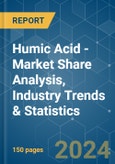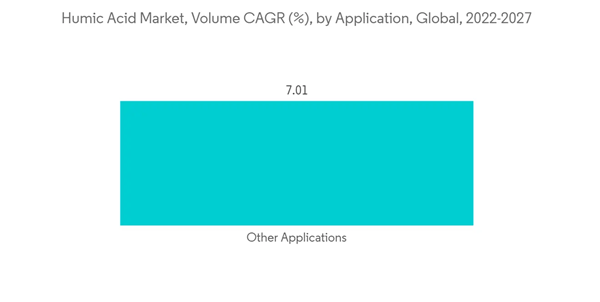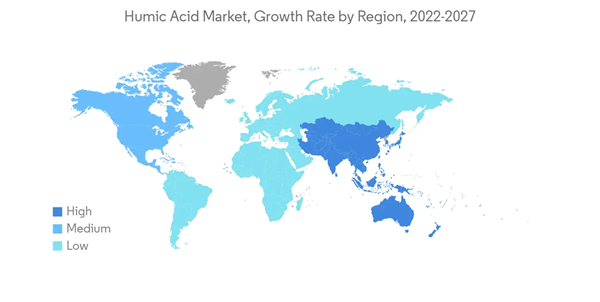The Humic Acid Market size is estimated at USD 0.79 billion in 2024, and is expected to reach USD 1.38 billion by 2029, growing at a CAGR of 11.61% during the forecast period (2024-2029).
The market was negatively impacted by COVID-19 in 2020. However, the COVID-19 outbreak has led to the blooming of home gardening, along with growing food insecurity across various regions of the world. Presently the market has now reached pre-pandemic levels.
This product will be delivered within 2 business days.
The market was negatively impacted by COVID-19 in 2020. However, the COVID-19 outbreak has led to the blooming of home gardening, along with growing food insecurity across various regions of the world. Presently the market has now reached pre-pandemic levels.
Key Highlights
- Over the short term, the major driving factors of the market are its massive demand from the agriculture sector.
- However, a lack of awareness among farmers is likely to slow down the market.
- Nevertheless, changing demographics, food habits in emerging markets, and the growing need for organic fertilizers and bio-stimulants are expected to increase the demand for humic acid over the forecast period.
- Europe dominates the market across the world, with the most substantial consumption from countries like France, Germany, and United Kingdom.
Humic Acid Market Trends
Organic Fertilizer Segment to Dominate the Market
- Humic acid is widely used in fertilizers to improve nutrient uptake, water retention, microbial growth, and soil structure. It also helps in the reduction of toxins.
- Humic acid offers a wide range of physical, chemical, and biological benefits. Humic acid also improves the cation-exchange capacity (CEC) and the oxygen content. The improved average water holding capacity thereby improving the soil fertility and plant growth. The fertile soil may contain a maximum humic acid content of 3% and whereas in peat, the humic acid content varies falls in the range of 3 to 10%.
- The physical benefits offered by humic acid include enhancing the soil structure and preventing high water and nutrient loss in sunlight and sand soils. It helps in converting the sand soils into fertile soils by decomposition.
- The chemical benefits include the neutralization of acid and alkaline salts and regulating pH value. The use of humic acid improves the absorption of both organic and mineral substances and retains water-soluble inorganic fertilizers.
- According to the OECD-FAO Agricultural Outlook 2021-2030, Asia-Pacific is the largest producer of agricultural and fisheries commodities. The region is expected to account for 53% of the global agriculture and fish output by 2030. The total value of production is projected to expand by 20% by 2030 in comparison to the 2018-20 base level.
- According to the US Census Bureau, the current population of the United States is expected to increase by 0.7-0.9%, driven by a high level of immigration. With the increasing per capita income and growing population level, the demand for food crops and cash crops is also estimated to increase. For instance, as per the FAO, food demand in the United States is expected to increase by 50-90% by 2050.
- Therefore, all the aforementioned factors are likely to drive humic acid consumption from organic fertilizer segment over the forecast period.
Europe to Dominate the Market
- Europe was found to be the major market for the consumption of humic acid, owing to increasing consumption from countries such as France, Germany, and United Kingdom.
- France is home to the largest agricultural sector in Europe. It is among the top producers in the world agriculture market and produces sugar beets, wine, milk, beef and veal, cereals, and oilseeds. However, the country experienced severe droughts, and according to France's main agricultural trade union, FNSEA, 14,000 farms out of 440,000 filed compensation claims following the extreme heat and lack of rain that ravaged France during the spring and summer. This had a significant impact on the demand for fertilizers, thereby affecting the humic acid market.
- According to the Organization for Economic Co-operation and Development, in France, the total agricultural land around accounted for 9,647 thousand hectares in 2020-21 and is expected to rise in the coming years, considering the increasing demand for food in the country. According to the INSEE (France), GDP from agriculture in France increased to EUR 8,076 million in the fourth quarter of 2021 from EUR 8,033 million in the third quarter of 2021. Such factors favor the demand for the studied market in the country.
- In Germany, about half of the land is used for agriculture. It is the third largest exporter of agricultural goods in the world. Grain is majorly cultivated on about one-third of the agricultural land of Germany, where wheat is the leading crop, followed by barley and rye. This is increasing the demand for fertilizers, thereby boosting the market for humic acid, as it is a rich source of plant nutrients.
- According to the Federal Statistical Office, the Gross domestic product (GDP) from agriculture in Germany increased to EUR 7.64 billion in the fourth quarter of 2021 from EUR 7.41 billion in the third quarter of 2021.
- In the United Kingdom, the Office for National Statistics, GDP from agriculture increased to GBP 3,157 million in the Q3 of 2021 from GBP 3,146 million in the Q2 of 2021, thereby supporting the growth of the studied market.
- The above-mentioned factors are likely to ascend the demand for humic acid across the application industries in Europe.
Humic Acid Industry Overview
The global humic market is partially consolidated in nature. Some of the key players in the market (not in any particular order) include Humic Growth Solutions Inc., Zhengzhou Shengda Khumic Biotechnology Co. Ltd, Humintech, Cifo Srl, and Mineral Technologies Inc.Additional Benefits:
- The market estimate (ME) sheet in Excel format
- 3 months of analyst support
This product will be delivered within 2 business days.
Table of Contents
1 INTRODUCTION
4 MARKET INSIGHTS
5 MARKET SEGMENTATION
6 COMPETITIVE LANDSCAPE
7 MARKET OPPORTUNITIES AND FUTURE TRENDS
Companies Mentioned (Partial List)
A selection of companies mentioned in this report includes, but is not limited to:
- Agbest Technology Co. Limited
- Arctech Inc.
- Black Earth Humic LP
- Cifo Srl
- Desarrollo Agrícola y Minero, S.A.
- Humic Growth Solutions Inc.
- Humintech
- Jiloca Industrial Sa
- Saint Humic Acid
- The Anderson Inc.
- Xian Shan Yuan
- Zhengzhou Shengda Khumic Biotechnology Co., Ltd
- Mineral Technologies Inc.
- Grow More Inc.
Methodology

LOADING...










